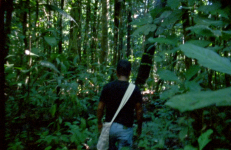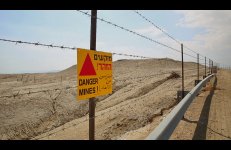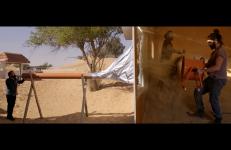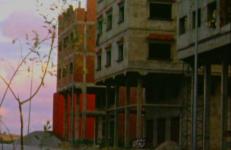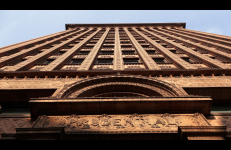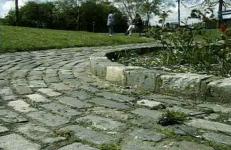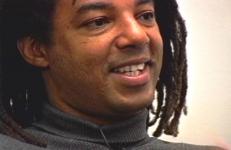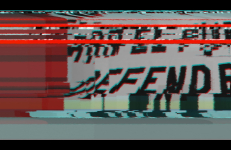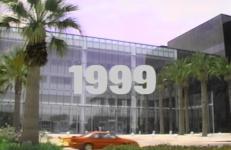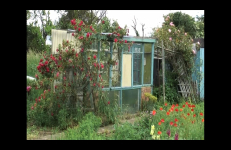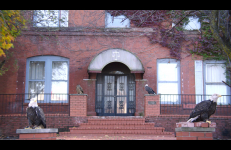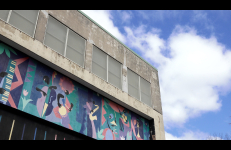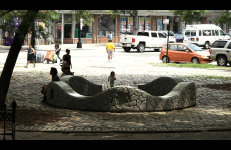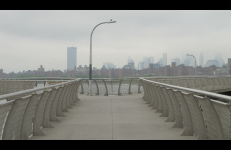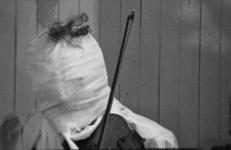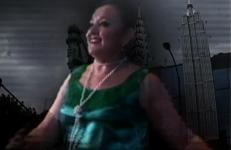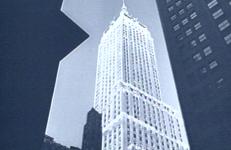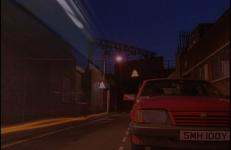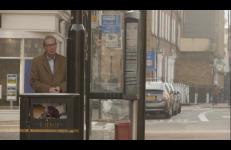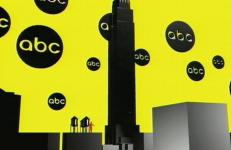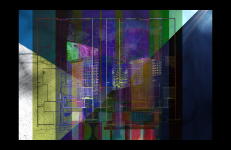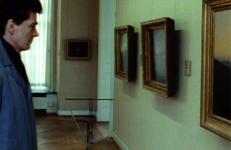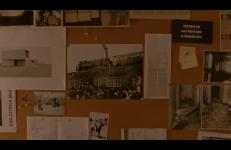A voyage into the labyrinthine memories of a Uitoto man, who worked for the drug Lords in the Colombian Amazon back in the 80s. Following his path between the forest and the ruin of a Narco's mansion imitating the Carrington mansion in the soap opera Dynasty, the film unfolds the hallucinatory account of a near-death experience.
Architecture
A series of unnatural deaths and departures (almost all, of men) disrupts the lives of nine families sharing an apartment building in Jerusalem.
Whether they inhabit the desert or are lost in it, three men are clearly confronted to the ruins of modern times. They are explorers or players or performers of times past. Their encounters, their moves, their assessment of location take the form of an acoustic sounding of space. Filmed in Shaabiyat al Ghurayfah in Sharjah, a repertoire of simple gestures playfully engages with structure, space, movement, threshold, surveillance and perspective.
A collaboration with writer Luc Sante made in Tangier, Morocco, a city where neither of us had ever been. En route from the airport to the city center, we found ourselves amazed by the landscape outside of the car windows; a massive construction project under way in all directions. While not in itself unusual, we were by struck dumb by the epic scale and seemingly incomprehensible plan of the development and were drawn to return together to this puzzling zone.
-- Jem Cohen
Buffalo, New York, which was once a prosperous city, is home to several architectural masterpieces built in the late 19th century to the early 20th century, such as the Darwin D. Martin House by Frank Lloyd Wright, the Guaranty Building by Louis Sullivan, and Kleinhans Music Hall by Eliel and Eero Saarinen. While some important buildings, including the Larkin Building by Wright, were demolished, the preservation movement has been active for the past several years. Architecture is embraced as a treasure, but it can be a burden to the city at the same time.
Lost Sound documents fragments of discarded audio tape found by the artists within a small area of East London, combining the sound retrieved from each piece of tape with images of the place where it was found. The work explores the potential of chance, creating portraits of particular places by building formal, narrative, and musical connections between images and sounds, linked by the random discoveries of the tape samples.
Lost Sound documents fragments of discarded audio tape found by the artists within a small area of East London, combining the sound retrieved from each piece of tape with images of the place where it was found. The work explores the potential of chance, creating portraits of particular places by building formal, narrative, and musical connections between images and sounds, linked by the random discoveries of the tape samples.
Awarded a MacArthur “Genius” Fellowship in 2014, Rick Lowe is a leading practitioner of social practice art. His Row Houses project is a highly lauded example of relational aesthetics successfully deployed. This interview focuses particularly on that work and the artist’s entrance into social practice.
The Templo Mayor was the center of the Aztecs' religious life in Tenochtitlán, a ceremonial building in the heart of Mesoamerica. A center of political battles of contemporary Mexico. A ritual of resistance.
Using the opening of Godard's film Alphaville as a foundation, Lord constructs a vision of the evolving global city during the last years of the 20th Century. Structured as a series of repetitions, the montage of the changing city is offset by shots of corporate Silicon Valley facades. The result is a dialectical contrast between urban and suburban space, body and mind, chaos and order, and the postmodern and the modern. Shot in Hi-8 video in Tokyo, Fukuoka City, Mexico City, Rome, San Francisco, Naples, and Los Angeles.
Memo Mori is a journey through Hackney tracing loss and disappearance. A canoe trip along the canal, the huts of the Manor Garden allotments in Hackney Wick, demolition, relocation, a magical bus tour through the Olympic park and a Hell’s Angel funeral mark a seismic shift in the topography of East London.
"I brought live reptiles, birds of prey and exotic flowers to a very stereotyped and neglected section of the city of St. Louis, Missouri which suffers from from severe abandonment and despair, but also has many tranquil vacant lots where nature flourishes. I chose these birds of prey for their symbolic meaning- The bald eagle a symbol of the United States, hawks and owls are messengers. But this is not a film about St. Louis, It's about an anonymous archetype more than a specific locale. St.
Urban parks consist of two major elements: nature and man-made forms. Parks play an important role in the urban environment, offering relief in everyday life. While parks provide green spaces, they are not natural spaces; they are highly designed. Nature and Geometry in the Park is a series of short videos that explore parks, focusing on form. Case 1 features Herbert Von King Park in the heart of Brooklyn’s Bedford-Stuyvesant neighborhood.
Urban parks consist of two major elements: nature and man-made forms. Parks play an important role in the urban environment, offering relief in everyday life. While parks provide green spaces, they are not natural spaces; they are highly designed. Nature and Geometry in the Park is a series of short videos that explore parks, focusing on form. Case 2 features Fort Greene Park in Downtown Brooklyn, which was originally the site of a fortification built for the Revolutionary War.
Urban parks consist of two major elements: nature and man-made forms. Parks play an important role in the urban environment, offering relief in everyday life. While parks provide green spaces, they are not natural spaces; they are highly designed. Nature and Geometry in the Park is a series of short videos that explore parks, focusing on form. Case 3 features WNYC Transmitter Park, a relatively new park located on the waterfront in Greenpoint, Brooklyn, which opened in 2012.
This is not a sight-seeing film, but a poetic journey through light and darkness reflected on the city of New York, where I often found empty spaces and times like Ma in Japanese. You do not often see the people walking on the streets or in the buildings, but you may feel the air and the light coming and going. It's not a deserted city, but a city full of energy that is there even without the people. You see the wind is blowing as the bubbles are floating over Wall Street, then up, up to the sky. The Sun sets under the Washington Bridge, where all the cars are runnin
A montage of architecture and cabaret, juxtaposing a second hand view of New York as refracted through this artist's eyes.
This title is also available on Half-Lies: The Videoworks of Ximena Cuevas.
No Damage is a composition made out of fragments from over 80 different feature and documentary films that show the architecture of New York City — its architectural presence as captured on film over eight decades. Lifted out of their original context and juxtaposed in groups, these scenes reveal their emotional implications: grandeur, glamour, the wake of modernism, post-modernism and, most recently, post 9/11 sentimentalism. A number of particular clips that resonate such emotions enter into a non-verbal discourse on age, status, functionality and aesthetics.
Nocturne is a 5-minute film shot entirely at night in deserted streets of London. The film attempts to find images of the city that reveal the presence of the past, or the presence of the dead, hinting at a concealed history. The deserted streets around the east end of London and Docklands reflect an echoic city filled with shadows. Nocturne is composed of long static viewpoints, each shot slowly unfolding in time as though by looking long enough the city's secrets will be revealed.
A watchful dog in a confusion of reflected chairs begins and ends Cohen’s finely tuned observational portrait of London’s Essex Street, and the inhabitants who work the shops and throng the pavement there. People hurrying, pausing, waiting or simply standing, intermingled with worn statues of historic peerage in the slanted light of late afternoon. A man holds a copy of The Law of Privacy and the Media as though testing its resilience against the quiet onslaught of an average work day.
Take a joyride through comfortable suburbia—a landscape molded by seductive television and corporate America (and keep in mind: disaster is another logo for your consumption...). This is the age of the "culture jammed" consumer preened with Friends hair, Survivor courage, and CNN awareness. A generation emptying their wallets for the most important corporate product of all: lifestyle. The psychological road trip across a slightly battered America travels at One Mile per Minute.
The Palace at 4 am is the experience of a fragile palace of collisions suspended in a montage vision. A hazy patchwork of structures. The Palace becomes visible only to repeatedly collapse in a liminal interference of the absence. An unrest landscape of the insight. Space-time of thresholds. This is The Palace at 4 am.
"Persistence was shot in 1991-92 in Berlin, and edited with films by U.S. Signal Corps cameramen in 1945-46, obtained from Department of Defense archives. Interspersed through these materials are filmic quotations from Rossellini's Germany Year Zero (1946). A meditation on the time just after a great historical event, about what is common to moments such as these—the continuous and discontinuous threads of history—and our attachment to cinematic modes of observation that, by necessity, shape our view of events.
Applying the same economy used in César's other films — one shot which uses the duration of an entire 16mm film reel — Porto 1975 is a tracking shot that unfolds at the social housing complex Cooperativa das Águas Férreas da Bouça, designed by Álvaro Siza Vieira as an integral part of the Ambulatory Service of Social Support (SAAL, 1972–76). The work's construction was initiated in 1975, but only completed in 2006.
Portuguese House is a journey throughout Lisbon, visiting the houses built by African communities from the Portuguese ex-colonies that have already been demolished. These houses, which were founded on dreams and not on drawings, thus became visible evidence of the right to housing, the right to build and to live in a house. Town planning and architecture are luxuries that do not guarantee access to happiness, in the same way that their absence does not invalidate it.




